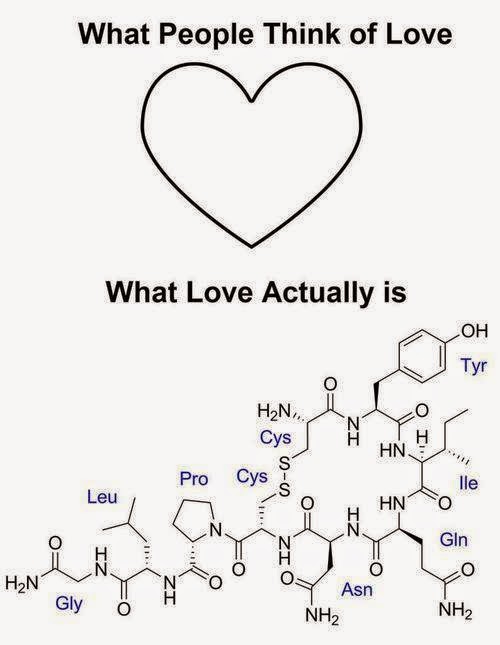Many an ‘80s band has pondered the timeless
question: Howard Jones asked “What
is Love”, Foreigner lamented “I Want To Know What Love Is”,
and both Survivor and
Whitesnake wondered
“Is This Love”, just to name a few. Recently, a pair of skeletons was
discovered in Leicestershire, England, holding
hands for the past 700 years. Well, either that or they were
thumb-wrestling enthusiasts.
 |
| "I wanna hold your hand" |
It is hard for us humans to imagine a world without love,
but the universe has been going about its business with complete dispassion for
billions of years. The appearance of life on Earth did little to change that at
first, but after a couple billion years, life forms began to emerge with brains
sophisticated enough to make love possible. So it is clear that love is not
requisite for life; for every animal that can experience love, there are billions
of bacteria living with that animal that do just fine without it.
 |
| Many of Earth’s creatures thrive without any need for love. |
Granted, bacteria divide asexually, so there is no need
to wine and dine a partner who is probably not going to return your 33 calls
anyway. You might think that love is needed for sex, but many life forms that
have sex, including parasites, plants, insects, and frat boys, do so without
love, further begging the question: why
does love exist?
At first sight, love would seem to be counterintuitive to
evolution, which is often characterized as the “blind
watchmaker” driven by “selfish
genes” tinkering to build the fittest survival machine. However, love can
confer extraordinary benefits to its practitioners, which is especially important
when their offspring are unfit to survive on their own after birth. Most
scientists agree that love evolved to prompt species to protect their offspring (this is known as kin selection*),
and this altruistic behavior often extends to others who share similar genes. A recent study from April
of this year has indeed shown that spouses tend to have
similar DNA, and we reported a study a few weeks ago about friends
having similar DNA. In other words, an objective analysis reveals that love
is a stealthy manipulation orchestrated by selfish genes in order to trick us
into protecting their legacy.
 |
| Certain dating web sites are capitalizing on the discovery that spouses share highly similar DNA. You can find your genetic soul mate by viewing the genes of potential partners as you check out what they look like in tight jeans. |
Back in the 80s we didn’t have technology that could
identify our genetically compatible companion, so we had to rely on the wisdom
of the great philosopher Sammy Hagar to teach us how we know “When It’s Love”.
Scientists have also made great strides in elucidating the biochemical basis for love with the discovery of oxytocin, aka the “love hormone” or the “cuddle chemical”, which floods the brain during pair-bonding events, such as sex, childbirth, or eating a Reese's Peanut Butter Cup. In addition to forging pair bonds during sex, oxytocin appears to be instrumental in causing moms to love and care for their kids. Rat mothers given an agent that blocks oxytocin release disregard their newborn pups. There is even a review article on oxytocin written by a Dr. Love – no joke!
 |
| Lou Gramm of Foreigner once crooned, “I want to know what love is, I want you to show me.” Here you go, Lou. |
So there you have it: love is an evolutionary tactic that helps us propagate our genetic legacy. Let’s see Barry White work that into a song. It is not the most romantic answer, but remember…just because we know how the roller coaster works doesn’t make the ride any less thrilling.
*It should be noted that kin selection is seen in many species, and not just animals. For example, kin selection is seen in insects and even in plants!
van Leengoed E, Kerker E, & Swanson HH (1987). Inhibition of post-partum maternal behaviour in the rat by injecting an oxytocin antagonist into the cerebral ventricles. The Journal of endocrinology, 112 (2), 275-82 PMID: 3819639
Domingue, B., Fletcher, J., Conley, D., & Boardman, J. (2014). Genetic and educational assortative mating among US adults Proceedings of the National Academy of Sciences, 111 (22), 7996-8000 DOI: 10.1073/pnas.1321426111

No comments:
Post a Comment